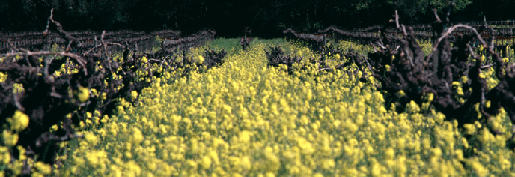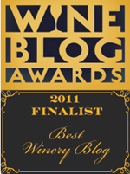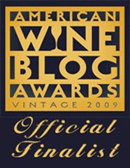A Trip Down Memory Lane
|
The other day my father and I drove through the Napa Valley together. We were headed to yet another wine industry financial conference for some pearls of wisdom. (It occurred to me that we could probably write the book on the subject ourselves!) I really can't recall the last time we were in the car together in Napa
it had to be years. As we meandered along Hwy. 29, awestruck by the beautiful mustard that colored the vine rows, Dad would occasionally point to properties that he had looked at buying all those years ago. One was near the old Ehlers Lane Winery, just before Charles Krug Winery. Another was at the southern end of the valley, just before the town of Yountville. It had some gnarly old vines and a beautiful Victorian home. I looked at that place, but didn't want to be 50 ft. off the highway. Figured that someday if the place ever got discovered, it might become a problem" Dad remarked. I then asked him what it cost back then. Gee, I don't know, it just seemed awfully expensive. Probably $3500-$4500 an acre. We both chuckled. |
 |
It made me wonder how things would have been different had we started up over there. What would we be known for? What would it have been like to grow up in the Napa Valley? How would our wines be perceived today? One thing's for sure, we probably would be charging 3 times the price. And, while it's sad but true we probably wouldn't be going to wine industry financial symposiums for pearls of advice. |
2 Comments
Leave a comment
welcome!
This is a blog about what it's really like to be in the wine industry...so sit back, take a sip and enjoy!

about me

our wines

our winery

our events

contact me

privacy statement

favorite posts
A Lifetime in Wine
Top 10 Traits of the Successful Family Winery
The Dreaded Family Meeting
Board Meeting Jitters
Is the Future of the Winery in Danger?
The Case of the Overweight Bottle
Wine and Dementia
Wanted: Talented (Normal) Individual for Family Owned Winery
A Sea of Wine
The Heroes of Our Industry
monthly archives
subscribe
Hopes & Dreams
Owning a Coastal Cottage
Sailing for 6 Months
Getting a 100 Point Score

Favorite Haunts
Coast of Maine
Dry Creek General Store
Dry Creek Kitchen
Healdsburg Bar & Grill
Spoonbar
Sonoma Country Antiques
Baci Cafe & Wine Bar
The Farmhouse
Istanbul's Grand Bazaar
Bad Ass Coffee
Bistro Ralph

Bits of Press
Food & Wine Magazine
The Wine News
Wine Enthusiast
Wine Spectator
Press Democrat
Sunset Magazine
Connoisseurs' Guide
Dan Berger's Vintage Experiences
Cruising World Magazine
Oprah Magazine
The Washington Post
Coastal Living Magazine
Wine & Spirits Magazine
People Magazine
SAG Awards Magazine
Forbes Magazine

Favorite Magazines
Coastal Living
Down East
Sunset
Country Living
Quarterly Review of Wines
Wines & Vines
Wine Spectator
Wine Enthusiast
California Grapevine
Connoisseurs' Guide
Practical Winery & Vineyard
WineReviewOnline
Vineyard & Winery Mgmt

Blog Buddy List
Fermentation
Hip Tastes
Pinot Blogger
All The Best
Julia Flynn Siler
Vinography
Winery Web Site Report
The Pour - Eric Asimov
Dr Vino
Steve Heimoff
Start Up Ladies
Good Wine Under $20
Blind Muscat
The Wineroad Blog
Gabe's View
Wine Peeps
Vici Vino
Cellarmistress' Cellar Talk
Uncork Life
WineVine-Imports Blog
The Wine Witch
SOURMASHED

Honorable Mentions
Fermentation
Wilma Hits The World of Blogs
Most Intriguing New Wine Blogs of 2008
Midwest Wine Guy
Winery of the Month
Julia Flynn Siler
Meritage wines - and a fascinating glimpse into family business
Winery Web Site Report
New Winery Blog: Wilma's Wine World
Start Up Ladies
Insider's View of Family Owned Dry Creek Vineyard
The Glue that Keeps the Whole Thing Going
Atlanta Dish
Blog of the Week
Blind Muscat
The Merits of Meritage
Wineries.net
Boston Wine Expo exhibitors, and the reason why winemakers are so darn happy




JohnLopresti
April 19, 2008 10:11 AM
These times are different from when I worked one autumn thru the next spring in DryCreek. Viticultural practices, like vinification art, and even cooperage, all have modernized and improved the quality of the wines yet adding challenges. When I first learned the various trades in the wine industry I always puzzled about facilities' strategies for nontablewine products, seemingly, to me, at that time, an unrewarding and distracting endeavor for an organization whose highest paradigm was production of superb varietal wine. Recently in a backwater supermarket in Cloverdale, however, I had occasion to taste a brandy that has a story much like what is happening in Dry Creek valley, and thought I would send a few links, so when you are contemplating business models you could balance the best vision of what Dry Creek appellation has to offer with the tale of what has developed in the region IV land considerably further north in our neighboring county.
Alambic still: http://www.jepsonwine.com/images/gallery/still.jpg
Schneider personal story: http://www.jepsonwine.com/who_we_are/winemaker_bio.pdf
I recall when I worked at DCV, Dave had a favorite entertainment by a family musicians group who would perform on the lawn outside the barrel room. So when I looked at the biography of the brandywinemaker in the links, above, I checked the website of the outfit where she used to work, up where vines have to endure winter snow, and heat summation always is problematic in WA; it looks like they have a vigorous summer entertainment schedule of music, like DCV.
There are many ways to connect with the public and integrate closely with the community, and lots of ways to improve the economics of winemaking innovatively. I hope the ideas which the Napa adventure provided will add to DCV's tradition of creativity and excellence.
Alexwebmaster said:
March 4, 2009 6:24 AM
Hello webmaster
I would like to share with you a link to your site
write me here preonrelt@mail.ru